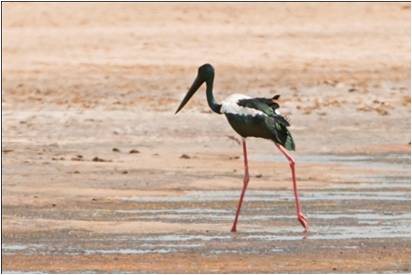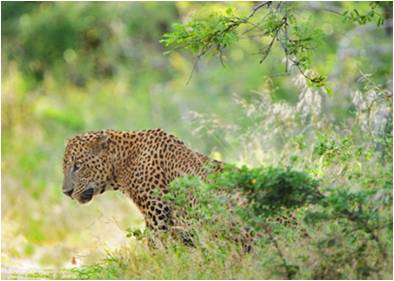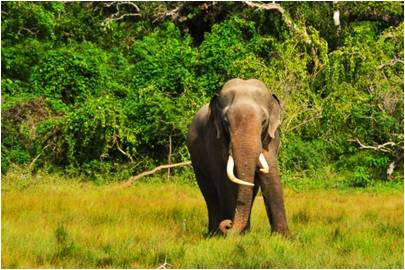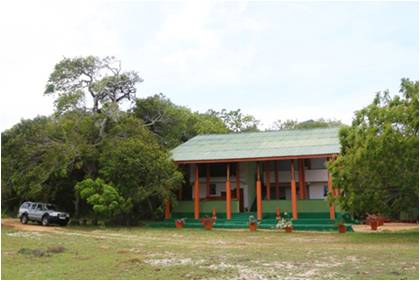Episode 10 – Kumana National Park

Tales from the past
I was first appointed to the post of Ranger in the Department of Wildlife Conservation in 1981. First, I had to work at ‘Wilpatthu National Park’ and thereafter, on the 1st of February 1983, I assumed duties at ‘Kumana National Park’. At the time, it was known as ‘Yala Eastern National Park’ or ‘Hokanda National Park’. It was very demanding work, my home was in Galle and the bus, which came to ‘Okanda Devalaya’,ran only on Fridays. For the rest of the week, I walked 12 miles to ‘Hokanda National Centre’ from ‘Panama’. This was my life for two years, till 1985.
To claim that 1985 was a tumultuous period in Sri Lanka would be an understatement. The country was still embroiled in a brutal civil war with the LTTE (Liberation Tigers of Tamil Eelam), and tensions were at an all-time high. After LTTE militants attacked Hokanda National Park on the 3rd of March, we were transferred to ‘Yala National Park’, where we would spend the following three years.
At the beginning of 1988, we came to know that local fishermen had squatted in Hokanda National Park and had set up illegal shanties beside the river. They have cleared the area of Mangroves and had taken to the lagoons to expand their fishing. Hokanda Park always held a special place in our hearts, and we felt quite hamstrung in our inability to intervene as our beloved park was being ravaged. Adding fuel to the fire of the political landscape of 80’s Sri Lanka was the threat of a radical, violent civilian uprising in addition to the ongoing civil war. Some radicals even broke into an office belonging to the Yala National Park and looted any valuables they could find, and the collective morale of all who care for the beloved park suffered a stinging blow. Over time, the deplorable situation deteriorated further and further, until the time came when the officers decided that we have had enough, and it was finally time to go on the offensive. So, we requested the Warden of Yala National Park, Mr. Edmond, permission to observe any suspicious activity and conduct a raid in Hokanda Park. Our request was granted.
We set out the next morning, at around 5.00 am from the ‘Palatupana’ head office on a tractor. Our team consisted of three Rangers, Manika, Gunadasa and I along with Assistant Ranger R.P. Karunasena. The other members were Sarath Indrapala, W. Rupasinghe, S.M. Anura Bandara, Nalaka Weerathunga, Somarathna Hettigoda, Premarathna Manamperi, Sepala Manamperi, and K. Karunasena. We crossed the ‘Manik’ river clearing any obstacles on the road, but when we were near ‘Gajabawa’ one of the front tires got punctured. We were left with no choice but to continue our mission on foot.
We walked a few miles, helping ourselves to the occasional fallen wood apple along the way. When we reached an area called ‘Madamthota’, we found it completely abandoned. The crudely constructed shacks were devoid of any inhabitants. After we had further travelled along the road for about three kilometers, we heard a noise, the distinctive sound of hammering iron. We followed the noise to find three people mining for gems, which is strictly illegal in this protected area. We arrested the miners and restrained them by tying their hands in the back, but now, we were left with no alternative but to take our new ‘friends’ along with us.
We walked eight more kilometers down the road adjoining the river till we reached the ‘Galwangedi’ area. We heard noises and followed the sound to find six men lunching in two shoddy huts. As before, we announced ourselves, restrained them and placed them under arrest. But now, our company was getting too big, and this is far more likely to attract unwanted attention. We decided to leave two of our own to keep an eye on the detained suspects and started off on our journey again. Not long after, we spotted several men on the road on bicycles carrying luggage. We did as we have done before, we announced ourselves and managed to arrest eleven men and confiscate materials in their person, despite a few being able to flee the scene.
And again, we set off to finish the task at hand. A while later, I noticed a man standing on the rocks in the middle of the river with a gun aimed at the direction of the treetops. He was in the middle of hunting Torque monkeys. None of us carried firearms in our person, the people who we were able to arrest were only intimidated by the authority that came along with being designated Rangers. If they had put up a fight and resisted arrest, well…things would very well have gone differently. To avoid getting shot, we realized it was of grave importance that we do not draw attention to ourselves by barging in and provoke the hunter into firing his weapon, and instead, opted to hide and wait for the unwitting hunter to come to us. We took our positions and hid until the unsuspecting hunter was surrounded. I went for his legs while the rest of the team were able to jump on and subdue him. After the hard part was over and done with, we added the restrained hunter to our new group of ‘no-do-wells’ and took off once more.
Along the way, a few kilometers out, we crossed into another clearing with a couple of huts, an oxen pulled cart, and four people. We adhered to the familiar protocol and added the new arrestees into our group of detainees and confiscated all belongings along with the cart and the oxen. Finally, around 3.00 pm, it was time to head back, and after we regrouped and made the long walk back to the tractor, the sun had already set, and twilight was giving way to the creeping night. We were momentarily startled by the sound of a helicopter passing overhead, but the rest of the journey back was largely uneventful and without hassle.
Looking back, I still breathe a sigh of relief to this day for our mission to have been completed without any of us suffering grievous injuries or God forbid, having the misfortune to cross paths with the LTTE, during a period in which civil unrest in the region and the dangers that accompanied it rose to devastating highs. I find myself slightly amused with one interesting little anecdote though, this remains the first and only recorded incident in which the Department of Wildlife Conservation had taken under its custody, an oxen cart!
This story serves asa brief telling in highlighting the exemplary courage and unparalleled dedication of the people who devote their lives to the care of our beloved wildlife parks.
Mr. Ranjith Sisira Kumara

Although Mr. Ranjith Sisira Kumara joined the casual Assistant Bungalow Keeper on November 25, 1981, he had qualifications of a Wildlife Ranger at the time. After nearly a year of service at Wilpattu National Park, was promoted to Kumana National Park as a Wildlife Ranger. He worked there for about three years and then at Yala National Park for seven years. Randenigala, Iginiyagala, Kataragama site, Hikkaduwa Marine National Park, Kalpitiya are some of the other places where he worked.
Ranjith Sisira Kumara is a clever Wildlife Ranger as well as a skilled diver. He has also made about 1,200 arrests. He has been active in wildlife litigation and has brought victory to the Department of Wildlife in a number of cases. It is a work he does very willingly.
Mr. Ranjith Sisira Kumara, who has passed the Wildlife Management Certificate Course at the Open University of Sri Lanka, has won gold medals as the batch top of three Certificate and Diploma Courses conducted by the Department. He has also won the International ‘Paddy’ Certificate for Swimming and Diving and has also won certificates from the Sri Lanka Special Task Force (STF) for being an accomplished sniper.
Ranjith Sisira Kumara andhis wifehas three daughters. He resides in Habaraduwa, Galle.
Kumana National Park
The dry zone is one of the most unique climatic zones in Sri Lanka. This is due to its inherent biodiversity. Sri Lanka has been able to occupy a leading position among the countries rich in biodiversity due to the ecologically diverse forest system scattered throughout the island.
Biodiversity similar to Yala National Park is found in Kumana National Park as well. Comparing the two national parks, Kumana National Park is home to a number of aquatic ecosystems that are not even found in terrestrial ecosystems. Therefore, more diversity of amphibians as well as aquatic life can be seen in Kumana National Park. Located on the beautiful coastline to the east and southeast with lush green this park is known as a bird paradise. Kumana National Park was declared in 1938 as a very important breeding ground for birds in Sri Lanka.
Kumana National Park falls under the Ampara and Moneragala administrative Districts, within the Pottuvil Electorate and the Panama Divisional Secretariat area. In 1969, it became a National Park, expanding up to 17,863.4 hectares in the year 1970. As of 05th July 2006, it has expanded to 35,665 hectares.
The Kumana Park is physically separated from the Yala National Park by the KumbukkanOya. Kumana National Park starts from Kudumbigala Okada and extends to KumbukkanOya, beyond which is Section II of Yala National Park. Therefore, Kumana National Park is also known as Yala East Park.
There are no high peaks here and you can see beautiful Rocky Mountains everywhere. Stone hills such as Kudumbigala, Bambaragasthalawa, Bagura, Kongala and KiripokunuHela bring a strange charm to the forest. Kumana National Park with its grasslands, coastal vegetation, rivers, forests, estuaries and thorn shrubs receives the highest rainfall during the Northeast monsoon season. It fills the lakes such as Okanda, Thunmulla, Divulpallama, EraminiyaWewa, AluthWewa and BakmiWewa. KumanaVillu formed around the KumbukkanOya estuary is a world famous Villu covering about 500 acres. Kumana Villus are submerged in seawater from time to time. The Park is home to about 20 lakes, lagoons and forests, which are ideal for many species of birds. The depth of the lagoons is less than 2 m.

Kumana National Park is located 391 km southeast of Colombo, close to the coast. The average annual temperature is around 27.30 degrees Celsius and the average annual rainfall is about 1,300 mm.
The origin of this area which belongs to an ancient civilization dating back to around the 3rd century goes back to the time of the Magama Kingdom. Stone inscriptions dating back to the 1st and 2nd centuries have been found around the area. Kumana National Park is located on the same road of the Kataragama Hindu Kovil, which is traditionally visited by Hindu devotees on annual PadaYatra.
When the biodiversity isconsidered, there are about 223 species of plants. Kon (Sheleicheraoleosa), Halmilla (Berryacordifolia), Malittan (Salvadorapersica), Thimbiri (Diospyrosmalabarica), Puswel (Entadapursaetha), Flame lily (Gloriosasuperba), Palu (Manilkarahexandra), Ceylon Satain wood (Chloroxylonsweietenia),Banyan(Ficusbenghalensis) and Sacred fig (Ficusreligiosa) as large plants, as well as in coastal areas plants like Wara (Calotropisprocera), Katuikill (Acanthus ilicifolius), Bin thaburu (Ipomoea pescaprae) can be seen and in freshwater ponds aquatic plants such as Olu (Nymphaeanouchali) and Lotus (Nelumbonucifera) are a sight to behold.
Kumana National Park is one of the most important and popular Bird National Parks in Sri Lanka, mainly due to its diverse migratory birds. More than 430 endemic, resident and migratory bird species are recorded in Sri Lanka. Bird watchers can easily observe over 200 species of birds here. During the April-July period, tens of thousands of Sri Lankan birds flock to the Kumana swamp to lay their eggs. Large flocks of native aquatic birds including the Purple heron (Ardeapurpurea), the Great egret (Casmerodiusalbus), and the Indian pond- horon (Ardeolagrayii).To take. Migratory birds come here but they do not lay eggs here. Common birds include the Black-necked stork (Ephippiorhynchusasiaticus), Lesser adjutant (Leptoptilosjavanicus), Painted stork (Mycterialeucocephala), Gray heron (Ardeacinerea), Purple swamp hen (porphyria porphyrio) Large numbers of aquatic birds such as Stork (Ciconiaepiscopus), Little Cormorant (Phalacrocoraxniger), Spotted billed pelican (Pelecanusphilippensis), Great cormorant (Phalacrocoraxcarbo) and carnivorous birds of eagle family such as Shikra (Accipiter badius), Brahmin kite (Haliasterindus) are also found here.




Kumana National Park is a famous National Park for Leopards (Pantheraparduskotiya). Tourists, wildlife enthusiasts and wildlife photographers regularly visit Kumana National Park to see as many leopards as there are in Yala and Wilpattu. With the intervention of the Department of Wildlife Conservation, Kumana National Park has become a Leopard paradise today. Known as a bird paradise in the past, this park is now a popular park where Leopards can be seen well.

In addition to leopards, Asian elephant (Elephasmaximus), Sloth bear (Ursusursinus), Ruddy mongoose (Herpestessmithii), Mongoose (Herpestesedwardsil), Porcupine (Hystrixindica), Golden jackal (Canisaureus), Wild Boar (Susscrofa) , Animals such as Deer (Muntiacusmuntijak) and Water buffalo (Bubalusbubalis) can also be seen there.




The fish diversity in the freshwater lagoon ecosystem of this park is immense. Morella (Zenarchopterusdispar), Uduppuwa (Butisbutis), Ganara (Channaara), Kanaya (Channagachua), Maspethiya (Puntiussarana) are among them. Shrimps, common prawns, lagoon crabs and little egret (EgrettaGarzetta) and several carnivorous birds are also found in association with mangrove eco-systems here.
Blue whale (Balaenopteramusculus), Asian elephant (Elephasmaximus), Leopard (Pantheraparduskotiya), Estuarine crocodile (Crocodylusporosus), Leatherback Sea Turtle (Demochelyscoriacea) and Black-necked stork (Ephippiorhynchusasiaticus), which are named as the top seven Wild animals in Sri Lanka can be seen in this National Park.

The Department of Wildlife Conservation has established a Turtle Conservation Center at Kirigalbe in the National Park for the conservation of turtle species that come to the Kumana beach. It has produced tens of thousands of baby turtles and released them into the ocean.
Located about 21 miles south of Pottuvil town, the access road stretches from Colombo, Ratnapura, Udawalawe, Wellawaya, Moneragala, Siyambalanduwa via Lahugala, Pottuvil, Panama, Okanda and Kudumbigala. The entrance to the park is in Panama; The Park office is located 22 kilometers from Panama. Two tourist lodges at Thummulla and Kirigalbe have been constructed for the convenience of tourists. Reservations can be made at the Head Office of the Department of Wildlife Conservation, Colombo. Camp sites have also been set up at Heraligasara, Kumbuka01, Kumbuka02, Galamuna and Moyataka to enjoy the natural beauty of the park.


List of animals in the Kumana document
Sinhala name | Tamil name | English name | Scientific name |
අලියා | ஆசிய யானை | Asian elephant | Elephas maximus |
කොටියා | புலி | Leopard | Panthera pardus kotiya |
තිත් මුවා | புள்ளி மான் | Spotted deer | Axis axis ceylonensis |
වල් ඌරා | காட்டுப் பன்றி | Wild Boar | Sus scrofa |
හිවලා | பொன்னிறக் குள்ள நரி | Golden jackal | Canis aureus |
වලහා | தேன் கரடி | Sloth bear | Ursus ursinus |
වල්හාවා | இந்திய முழி முயல் | Black napedrabbit | Lepus Nigricollis |
ඉත්තෑවා | முள்ளம்பன்றி | Porcupine | Hystrix indica |
මුවා | இந்திய மான் | Deer | Muntiacus muntijak |
වල් මී හරකා | காட்டெருமை | Water buffalo | Bubalus bubalis |
මුගටියා | இந்திய சாம்பல் கீரிப்பிள்ளை | Mongoose | Herpestes edwardsil |
හෝතම්බුවා | சிவந்த கீரி | Ruddy mongoose | Herpestes smithii |
කරවැල් කොකා | செந்நாரை | Purple heron | Ardea purpurea |
ලතු වැකියා | மஞ்சள் மூக்கு நாரை | Painted stork | Mycteria leucocephala |
ලොකුසුදුකොකා | பெரிய கொக்கு | Great egret | Casmerodius albus |
තිත් හොට පැස්තුඩුවා | சாம்பல் கூழைக்கடா | Spot- billed pelican | Pelecanus philippensis |
Sinhala name | Tamil name | English name | Scientific name |
කණ කොකා | இந்திய குளத்துக் கொக்கு | Indian pond- horon | Ardeola grayii |
අලිමානාවා | கறுப்புக் கழுத்து நாரை | Black-necked stork | Ephippiorhynchus asiaticus |
හීන්මානාවා | சிறுத்த பெரு நாரை | Lesser adjutant | Leptoptilos javanicus |
අළු කොකා | சாம்பல் நாரை | Grey heron | Ardea cinerea |
පොදු දම් කිතලා | நீலத் தாழைக் கோழி | purple swamphen | porphyrio porphyrio |
පාදලි මානාවා | வெண் கழுத்து நாரை | Woolly-necked stork | Ciconia episcopus |
පුංචි දිය කාවා | சின்ன நீர்க்காகம் | Little Cormorant | Phalacrocorax niger |
මහා දියකාවා | பெரிய நீர்க்காகம் | Great cormorant | Phalacrocorax carbo |
කුරුළු ගොයා | வைரி | Shikra | Accipiter badius |
බ්රහ්මණ උකුස්සා | செம்பருந்து | Brahming kite | Haliastur indus |
පොරෝලුවා | கொண்டலாத்தி | Common hoopoe | Upupa epops |
කස්බියානු මුහුදු ලිහිණියා | கஸ்பியன் ஆலா | Caspian tern | Hydroprogne caspia |
වල් පොල්කිච්චා | சோலைபாடி | White rumpedshama | Copsychus malabaricus |
ඇලි කොකා | சின்னக் கொக்கு | Little egret | Egretta garzetta |
ගැට කිඹුලා | செம்மூக்கு முதலை | Estuarine crocodile | Crocodylus porosus |
දාර කැස්බෑවා | பேராமை | Leatherback Sea Turtle | Demochelys coriacea |
පොතු කැස්බෑවා | அழுங்காமை | Hawks bill | Eretmochelys imbricata |
නිල්තල්මසා | நீலத் திமிங்கிலம் | Blue whale | Balaenoptera musculus |
මොරැල්ලා | மொரெல்லா | Morella | Zenarchopterus dispar |
උඩුප්පුවා | உடப்புவா | Uduppuwa | Butis butis |
ගංආරා | பூவிரால் | Ganara | Channa ara |
කනයා | கனயா | Kanaya | Channa gachua |
මස්පෙතියා | மஸ்பெதியா | Maspethiya | Puntius sarana |
කූනිස්සා | தசக்காலி ஓட்டு மீன்கள் | Shrimp | Shrimp species |
ඉස්සා | இறால் | Prawn | Prawn species |
කලපු කකුළුවා | களப்பு நண்டு | Lagoon crab | Lagoon crab species |
ගෙබි විශේෂ | தவளை வகைகள் | Frog and toad | Frog and toad species |
List of trees in the Kumana document
Sinhala Names | Tamil Names | English Names | Botanical Name |
කෝන් | பூக்கம் | Kon | Sheleichera oleosa |
හල්මිල්ල | சாவண்டலை மரம் | Halmilla | Berrya cordifolia |
මලිත්තන් | உகாய் | Malittan | Salvadora persica |
තිඹිරි | பத்திரி | Thimbiri | Diospyros malabarica |
පුස්වැල් | யானைக் கொழிஞ்சி | Puswel | Entada pursaetha |
නියගල | செங்காந்தன் | Flame lily | Gloriosa superba |
පලු | பாலை | Palu | Manilkara hexandra |
බුරුත | முதிரை | Ceylon Satain wood | Chloroxylon sweietenia |
නුග | ஆலமரம் | Banyan | Ficus benghalensis |
බෝ | அரச மரம் | Sacred fig | Ficus religiosa |
වරා | வெள்ளெருக்கு | Wara | Calotropis procera |
කටු ඉකිළි | கழிமுள்ளி | Katuikill | Acanthus ilicifolius |
බිං තඹුරු | அடும்பு | Bin thaburu | Ipomoea pescaprae |
ඕලු | நெய்தல் மலர் | Olu | Nymphaea nouchali |
නෙළුම් | தாமரை | Lotus | Nelumbo nucifera |
Editor– Dammika Malsinghe, Additional Secretary, Ministry of Wildlife and Forest Conservation (MWFC)
Article on park written by – Hasini Sarathchandra, Chief Media Officer, Department of Wildlife Conservation (DWLC)
Tamil Translations – A.R.F. Rifna, Development Officer, MWFC
English Translations (Documents) – Asoka Palihawadana, Translator, MWFC
English Interpretation (Story) – Thanuka Malsinghe
Web Designing- N.I.Gayathri, Development Officer, MWFC
Photography – Rohitha Gunawardana, DWLC
Sinhala typing & other assistance – Aruni Palapathwala, MWFC